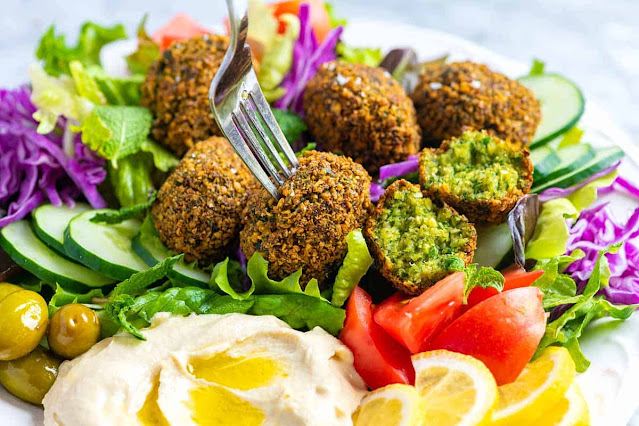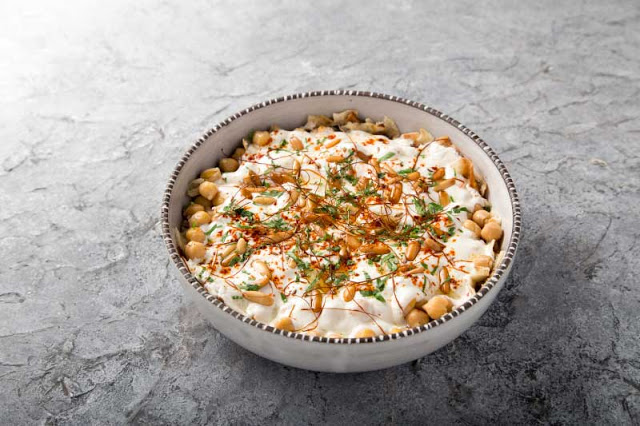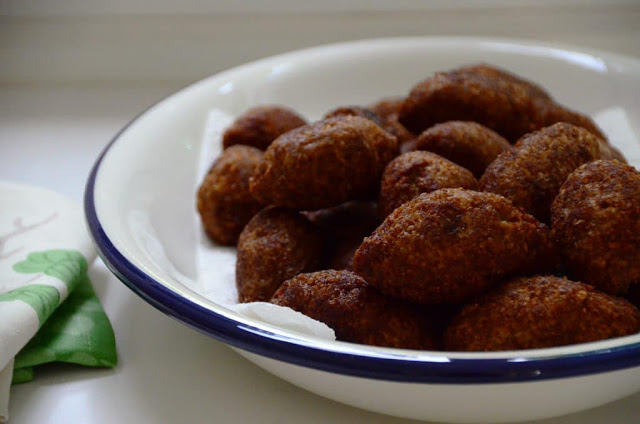Top 10 Most Popular Lebanese Dishes
1. Hummus
(Houmous, Hommus, Hummus b’tahini)
This internationally popular, beige-colored spread is traditionally made with mashed chickpeas, tahini sesame paste, lemon juice, and garlic. People across the world love hummus for its tangy flavor and the fact that it is filled with nutrients.
When served, it is typically dressed with a drizzle of olive oil, and is then used as a dip for vegetables or a flavorful filling for flatbreads such as pita. Even today, not much is known about its origins, although the earliest mention of hummus dates back to 13th-century Egypt.
Hummus is sometimes additionally enriched with spices such as cumin and paprika, and it can be garnished with anything from fresh herbs, cucumbers, and chopped tomatoes to olives, pine nuts, and hard-boiled eggs.
SERVE WITH
2. Ma'amoul
(معمول, Mamoul, Mamool, Maamoul)
Ma'amoul is an ancient cookie filled with fruits and nuts such as dates, walnuts, and pistachios. The cookies are traditionally prepared for Easter, festivals, and celebrations, and they are typically shaped into balls or domes. In order to differentiate the cookies, the walnut version is usually shaped into a dome with a round top, the date ma'amoul is shaped into a dome with a flat top, while the pistachio ma'amoul has an elongated, oval shape.
It is not uncommon for the cookies to be topped with powdered sugar for extra sweetness, and they are often served with coffee or tea during the day in many Middle Eastern households.
SERVE WITH
3. Falafel
(Ta'meya)
Falafel is a deep-fried ball or patty made from ground chickpeas, fava beans, or both. Falafel is a traditional Middle Eastern food, commonly served in a pita, which acts as a pocket, or wrapped in a flatbread known as taboon; "falafel" also frequently refers to a wrapped sandwich that is prepared in this way. The falafel balls are topped with salads, pickled vegetables, hot sauce, and drizzled with tahini-based sauces. Falafel balls may also be eaten alone as a snack or served as part of a meze tray (assortment of appetizers).
Falafel is a common dish eaten throughout the Middle East. The fritters are now found around the world as a replacement for meat and as a form of street food.
SERVE WITH
4. Shawarma
(Shawurma)
Marinated and spit-roasted, shawarma is a delicious Middle Eastern meat treat whose origins can be traced back to the Ottoman Empire era, while its name stems from the Arabic pronunciation of the Turkish word çevirme (lit. to turn; turning), and refers to the rotating skewer on which the meat is cooked.
Shawarmas are made with either lamb, turkey, chicken, beef, or a mix of different meats which are slow-cooked for hours and basted in their own juices and fat, gaining an incomparable succulence, but the real secret to a perfect shawarma is in the marinade.
Depending on the variety, the meat must be marinated for at least a day, preferably two, especially when using beef. These marinades are either yogurt or vinegar-based and typically include spices and flavorings such as cinnamon, cloves, cardamom, nutmeg, black pepper, allspice, dried lime, spicy paprika, garlic, ginger, lemon, bay leaf, and sometimes even orange slices.
Shawarma is traditionally served either on its own or enjoyed tucked inside a warm flatbread such as pita or lavash. However, what really sets it apart from the Turkish döner kebab, Greek gyros, or other similar foods is the extent of garnishes and condiments offered with it.
Shawarma is often complemented with garlic mayo or a zesty toumaia garlic sauce, both fresh and pickled vegetables, salads like tabbouleh or fattoush, and amba sauce–a tangy chili and mango pickle dip.
Once a common staple of the Middle Eastern working man, shawarma has today become the ultimate Arabic street food, found not only in Arabia and Levant but in virtually any nook and corner of the globe.
5. Manakish
(مناقيش, Lebanese Pizza, Manaqish, Manaeesh, Manakeesh, Managish)
Manakish is a favorite Lebanese breakfast - a round, flat bread that is typically topped with olive oil and zaatar (sesame seeds, thyme, and sumac), then baked in the oven. Other toppings might include cheese, minced lamb, spinach, or fried eggplants.
The name of the dish means decorated or stamped, referring to a technique where the dough is pressed using the tips of one's fingers, leaving a decorative pattern in the process. Although it is sometimes affectionately called Lebanese pizza, it is a recent addition to the Lebanese culinary heritage, but it quickly became one of the most popular dishes due to its flavors, low price, and the ease of preparation.
Manakish is often associated with being food for the poor, but it is enjoyed by all classes of society. It is recommended to pair it with tomatoes, cucumbers, yogurt cheese, or a cup of hot tea.
6. Tabbouleh
(Tabouli, Taboule, Taboli, Tabouleh, تبولة)
Tabbouleh is a colorful Lebanese national dish that is usually considered a salad, with a crunchy and chewy texture, made with fresh, finely chopped parsley leaves, olive oil, bulgur wheat, and chopped mint leaves as a base. It originated in the mountains of Lebanon and Syria, where edible herbs that are used in tabbouleh were consumed by Arabs since Medieval times.
Usually served as an appetizer, it is sometimes accompanied by pita bread, baba ghanoush, or hummus. Chopped red tomatoes, diced cucumbers, fresh lemon juice and minced onions can be added to the salad, imparting a tangy flavor. It is best to refrigerate tabbouleh for a few hours before serving to improve its taste.
Its refreshing flavors are ideal for a hot summer day, while bulgur provides a rich source of fiber, protein, and minerals, making tabbouleh one of the healthiest food options in Lebanon. Tabbouleh is so popular that it even has its own day, celebrated every year on the first Saturday in July.
7. Fattoush
(فتوش, Fattush, Fatush, Fattoosh)
Fattoush is a simple salad made with traditional pita bread as a base on which the rest of the ingredients are built on. Pita bread is torn or cut into small bite-sized pieces, then toasted, grilled, or fried. It is then mixed with a variety of vegetables such as lettuce, radish, crunchy cucumbers, cherry tomatoes or regular tomatoes, peppers, onions, and (occasionally) garlic.
All ingredients are chopped and cut into pieces and mixed with a generous amount of herbs, most commonly mint and parsley. The final touch to this authentic salad is the dressing, usually made with olive oil, lemon juice, and pomegranate syrup. The key ingredient, next to the crunchy pita bread, is sumac - a spice commonly used in the Levantine area.
Sumac can be added to the dressing, and it is usually sprinkled on top of a prepared salad. It gives the dish a slightly tart taste and zest, which perfectly matches with the gentle flavors and aromas of fresh herbs and vegetables. The original fattoush is highly versatile, and other common additions may include crisp pomegranate seeds, olives, yogurt, and feta cheese.
It is one of the most famous salads frequently eaten in Lebanon, Syria, Palestine, Jordan, and Iraq. This refreshing salad belongs to a group of dishes popularly called fattat, which use the stale pita, or any other flatbread, as the star ingredient.
8. Sfiha
(Lahm Bi Ajĩn , صفيحة, Pide, Esfiha)
Sfiha, or lahm bil ajĩn (lit. meat on dough) is an Arabic specialty that dates back to the 15th century, when it first appeared in today's Eastern Lebanon. The traditional open-faced meat pie is popular throughout the Arab region, its main ingredients usually including minced lamb, chopped onions and tomatoes, spices, olive oil, and yogurt.
Originally, the dish was prepared by stuffing ground lamb and spices in brined grape leaves, but it evolved over time. Sfiha is also popular in Brazil and Argentina, where it was brought over by Levantine immigrants. It is usually consumed hot as a snack, accompanied by tahini sauce or a bowl of yogurt, while pomegranate seeds, coriander, or chopped cucumbers are often used as garnishes.
9. Fatteh
(فتّة, Fetté, Fatta)
Fatteh is a Levantine specialty made by combining pieces of fresh, toasted, or stale flatbread with numerous other ingredients. The name of the dish means to tear into small pieces, referring to the process of tearing the flatbread. Fatteh is usually consumed for breakfast or in the evening as the main dish.
There are two main varieties of fatteh - Levantine and Egyptian. The Levantine version is traditionally topped with yogurt, chickpeas, olive oil, and cumin. After the main toppings, Levantine fatteh can additionally be topped with chicken, lamb, or pine nuts.
The Egyptian version is usually prepared for feasts and is topped with rice, tomato sauce, garlic, and vinegar. Fatteh does not need to look neat, and is very easy to prepare, so even the most careless cook can turn the dish into a masterpiece, which might be the key to its popularity.
10. Kibbeh
(Kibbe, Kebbah, Kubbeh, Kubbah, Kubbi, Kebbeh, Kebbe)
Kibbeh is a unique mixture of soaked bulgur wheat and other ingredients, typically lamb meat, and it is also considered the national dish of Lebanon. Fragrantly spiced and eaten as a snack for casual or celebratory meals, Kibbeh can be raw, baked, fried, stuffed, or prepared in a vegetarian version, stuffed with potatoes, pumpkins, and tomatoes.
It is typically served with mint leaves and drizzled with olive oil. The word kibbeh stems from an Arabic verb meaning to form into a ball or a circular shape. A fried variety of kibbeh, called kibbeh nabilseeyah is shaped into a ball, stuffed, then fried in oil.
Raw kibbeh is called kibbeh nayyeh, where bulgur and meat are combined with spices and pureéd onions, kneaded together with some ice water, then placed into traditional flatbreads. Traditionally, the Lebanese used to kill animals on Sundays and feast days, so the raw meat was eaten immediately, and that's how kibbeh nayyeh came to be.

















Post a Comment